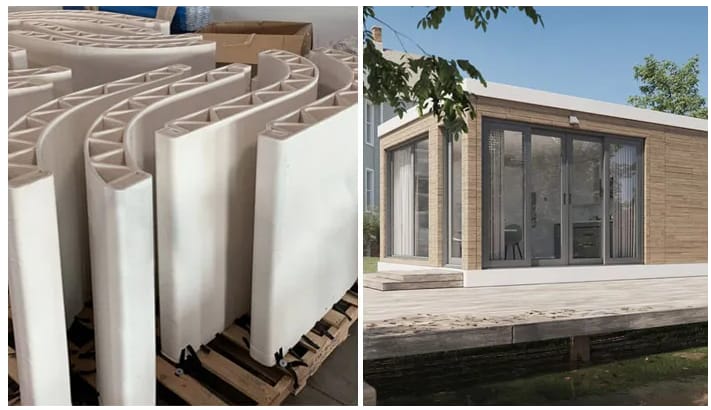
💼 Housing in 3D
briefcase | invest smarter | Issue #144
Breaking News: Pennsylvania firefighter Andrew Bischof has been arrested and charged with starting four fires, setting them and returning moments later to put them out.
In unrelated news, Andrew is also applying to be the new Federal Reserve Chairman 🥁🥁
Now, on to the show…

🧱 3D Housing: Just Another Brick in the Wall?
What’s more legacy than the age-old home construction industry? We’ve been doing it pretty much the same way for centuries. In fact, we’ve probably gotten worse at building quality over the years.
Give me a century-old home over the newer suburb tract-built McMansions any day!
Either way, we’re due for some innovation in the home construction space.
Enter Mighty Buildings, a home builder that uses 3D-printed wall panels and prefabricated technology to build homes. Recently, they raised $52M to expand their building technology to international markets amidst the ongoing global housing and labor shortages companies like it are trying to solve.
Mighty Buildings is one of dozens (Hive, ICON, SQ4D, even NASA) who are trying to change the construction industry, which has been challenged by low productivity and a lack of technological innovation for decades.
According to a recent survey, 66% of consumers would consider living in a 3D-printed home.

Further, despite this being a new technology, a full 30% of respondents said that 3D-printed homes will eventually overtake traditional home construction methods.
So is this just a fad, or are we on the cusp of revolutionary technology that can help us build faster, solve affordability and homelessness, and be kinder to the environment?
The answer is… multi-dimensional. But first, how cool is this?
@thelayerlord Getting ready for live printing at #ibs2022 with @blackbuffalo3d #3d #3dcp #oddlysatisfying #3dprinting #orlando #foryou #concrete #affordablehousing
👓 3D Promises
According to research, the global 3D printing construction market size was valued at $1.4B in 2021, but is projected to reach an astounding $750.8B by 2031. That is a compounded annual growth rate of 87.3% between 2022-2031.
Leading the charge globally is the Asia-Pacific region, which currently commands the largest share of the global 3D printing construction market. With a projected CAGR of 99%, the Asia-Pacific region will benefit tremendously as a manufacturing hub (jobs!) and the climate, durability, and affordability benefits of 3D-printed housing.
In Borneo, Malaysia, for instance, the first 3D home was printed in just 46 hours, showing the promise of mass-producing these climate-resistant dwellings at a low cost.

👓 Costs & Time
Zach Mannheimer, CEO of Alquist 3D, says that 3D-printed houses are already 5%-10% cheaper than traditional builds in the United States. Further, a study from 2018 in the academic research publication IOP Science: Materials Science and Engineering, suggests that 3D printing can reduce costs by at least 35%.

This is a game-changer in an industry where margins are razor thin, particularly amidst higher rates and higher labor costs.
Adding to the financial viability equation is timing. Construction industry specialists say that a final 3D-printed home can be ready in as little as a month and a half, as opposed to the 6-12 months it takes to build a typical house.
👓 Environment
Moving back to Mighty Buildings, the company’s process uses 60% recycled glass, has structures that are 5x the strength of standard concrete, is 70% of the weight of a traditional home, and produces fewer carbon emissions during manufacturing.
Now you’re just bragging!
Remember that traditional cement accounts for a whopping 8% of global CO2 emissions, so using recycled material instead could be an environmental game-changer.

Mighty Buildings’ products can withstand winds up to 180 miles per hour, which is hurricane-force. It also meets the California Building Code, including Title 24 Energy requirements and other regulations.
In a time where climate events are only increasing, this benefit to 3D homes is significant.
Other research has backed up these claims, with one study suggesting that 3D printed homes have “the potential to reduce construction waste by 30–60%, labor cost up to 50–80% and construction time by 50–70%.” If proven true, this is a 3D movie that will blow our collective minds.
Another study found that 3D-printed bathrooms can reduce 25.4% in overall costs, drop CO2 emissions by 85.9%, and save 87.1% in energy consumption compared to traditional precast bathroom products.
👓 Supply
In the single-family home market, 3D printing has the potential to put up large-scale developments quickly. For instance, in Austin, homebuilding giant Lennar, alongside partner ICON, is starting a 100-home community next year entirely from 3D printing.
Lennar says its 3D-printed homes will be as resilient and energy-efficient and will be able to be built faster than conventional construction methods...[Their] construction system can create homes and structures up to 3,000 square feet that are built to code...[the] wall system and materials are strong and longer-lasting than traditional building materials and can withstand extreme weather. It also says its products can be printed at high speeds and at scale.
ICON deployed its 46.5-foot-wide Vulcan printer, which consists of a crossbar that moves up and down between two 15.5-foot-tall towers that straddle the foundation. Attached is a nozzle that shuttles from side to side, layering Lavacrete, a proprietary concrete mixture, which takes about 15 minutes to dry.
This will be the largest 3D home development in the U.S. These printed houses use concrete framing instead of traditional lumber, and can be completed off-site. The 15-foot tall printers can build the exterior and interior wall system for a 2,000-square-foot home in about a week with only three laborers.
🤯 Compare this to the weeks a job like forming and framing alone takes, alongside dozens of tradespeople.
👓 Paper Jams
The biggest headwind facing 3D-printed homes is bureaucratic red tape and legacy regulations. After all, affordable housing is illegal.
More and more decision-makers and governments are realizing that the only way to solve our housing crisis is to build more. 3D-printed homes offer a shortcut to adding more housing supply en mass if the gatekeepers choose to get out of the way.
There’s also potential in the multifamily space, with one company in Germany stacking up 3D-printed apartment buildings.
There will be sequels to this movie. We are only in Act 1 of the revolution happening in homebuilding, and the future looks bright.
So What? In general, legacy construction practices are in for an awakening of historical proportions. 3D printing is one of those innovations that will change the industry for the better and help improve affordability, reduce our carbon footprint, and ease supply constraints.
It’s only a matter of time.
